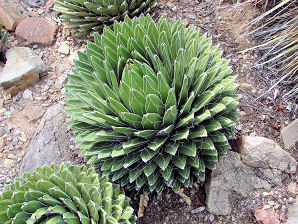Xeriscape Landscape Plants & Flowers
For The Arizona Desert Environment.
Pictures, Photos, Images, Descriptions, & Reviews.
Queen Victoria Agave, Agave victoriae-reginae.
We Are Proud Of Our SafeSurf Rating!
Click On Any Of The Following Links By Amazon.Com
For Books, & Videos About Wildflowers Of Arizona & The Southwest USA. No Obligation!
 |
| Queen Victoria Agave, Agave victoriae-reginae. Arizona - Sonora Desert Museum. Near Tucson, Arizona. September 29, 2006. |
|---|
 | |
| Queen Victoria Agave. Agave victoriae-reginae. | Queen Victoria Agave. Agave victoriae-reginae. |
|---|
 /
/

Queen Victoria Agave.
We wish to thank Wikipedia, the free encyclopedia for some of the information on this page. We share images and information with Wikipedia. Agave victoriae-reginae is named after the English queen Victoria. Queen Victoria's agave is a species of agave which forms a compact rosette of short, rigid, dark green, spine-tipped leaves with conspicuous white markings and smooth, toothless margins. It is a very nice agave but it does have a very sharp terminal spine at the end of each leaf. Some plants will lose their white markings, and when this happens, the markings usually never come back. Agave victoriae-reginae is a slow growing plant and it may take as long as 40 years before it ever blooms. When it blooms it sends up a flower stalk that is 10 to 15 feet tall with pale green to cream flowers. The plant dies soon after blooming. The slow growth creates a rather steep price for mature specimens. But, it also means that the plant will be around for a while if planted young. Agave victoriae-reginae is found across the Chihuahuan Desert, where there are about a half-dozen subspecies located. It is cold-hardy as agaves go to about 10� F. Can take full sun in Phoenix or Tucson.
Quick Notes:
Height: Up to 3 feet tall and 3 feet wide.
Flowers: Its flowers are pale green to cream flowers on 10 - 15 foot unbranched spikes.
Flowering Time: Phoenix Arizona, Mid February.
Leaves: The leaves symmetrical rosettes of narrow, dark green leaves. They have a slight red - brown tip. Be very careful of the sharp spines on the leaves.
Found: Native to northern Mexico, in Coahuila, Durango, Nuevo Leon, & Chihuahua. It is endangered there!
Hardiness:
Soil pH requirements:
Sun Exposure:
Elevation: 0 - 5,000 feet. In Arizona.
Habitat: Native in sand, sandy loam, clay and other heavy soils. It needs good drainage and aeration. It is remarkably tolerant of alkali. Hardy to 10� F.
Miscellaneous: Maintenance: Low. Photos Taken; Arizona - Sonora Desert Museum, near Tucson, Arizona. September 29, 2006.
|



We Are Proud Of Our SafeSurf Rating!
Click On Any Of The Following Links By Amazon.Com
For Books, & Videos About Xerioscape Plants Of Arizona & The Southwest USA. No Obligation!
Back To Arizona Xeriscape Landscaping Main Page.
Back To Xeriscape Succulents Page Three.
Back To Arizona Wild Flowers Home Page.
Back To DeLange Home Page
© 1966 - Present, Audrey, Eve, & George DeLange
| © 1966 - Present, Audrey, Eve, & George DeLange |

